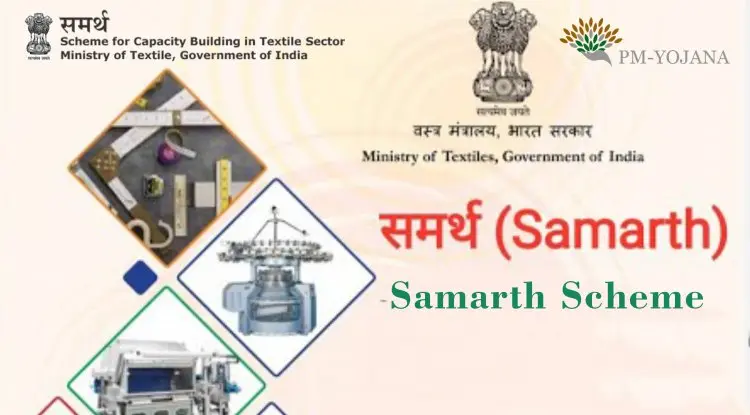Samarth Scheme
The Ministry of Textile is implementing Samarth Scheme, a flagship Scheme for Capacity Building in the Textiles Sector (SCBTS).

Samarth Scheme
The Ministry of Textile is implementing Samarth Scheme, a flagship Scheme for Capacity Building in the Textiles Sector (SCBTS).
Samarth Scheme 2022 Training,
Employment of Youths in Textiles Sector
A new scheme has been announced by the Central Government for launch under the supervision of the Textiles ministry. The new scheme is termed as “Samarth Scheme – 2018” and is more focused on offering with employment opportunity and training to the employees within the textile sector. The government has already made it clear that it will focus on offering with skill development and training to the youths related to the textile sector.
With the new implementation the central government aims at offering youths with a chance of encouraging sustainable employment within Textile sector. Under this newly implemented scheme the central government aims at offering over 10 lakh selected youths to undergo skill development training programme
| Name | Samarth Scheme |
| Full Form | Capacity Building in Textile Sector (SCBTS) |
| Approved By | Narendra Modi |
| Helpline Number | 1800-258-7150 |
| Supervised By | Ministry of Textile |
| Training Period | 3 years during 2017-2020 |
| Official Portal | http://samarth-textiles.gov.in/ |
Objectives of the Samarth Scheme
- It will provide National Skills Framework Qualification (NSFQ) compliant skilling programmes to over 10 lakh persons.
- The skilling programmes offered under Samarth Scheme aim to incentivize and supplement the efforts of the Textile industry.
- The scheme aims to create more jobs in the textile and related sectors that will cover the entire value chain of the textile but will exclude spinning and weaving.
- Traditional sectors of handlooms, handicrafts, sericulture and jute will be upgraded through skilling and skill upgradation.
- Through skill upgradation of lakhs of persons, it aims to induce self-employment capabilities among youth and others.
- It aims to promote sustainable livelihood to all sections of society.
Salient Features of Samarth Scheme
- Training of Trainers (ToT) – That will provide enhanced facilitation skills to the master trainers.
- Aadhar Enabled Biometric Attendance System (AEBAS) – That will ensure the credibility of the trainers and the beneficiaries.
- CCTV recording of training programmes – To avoid major conflicts in the functioning of the scheme, training institutes will be fixed with CCTVs.
- Dedicated call centre with helpline number –
- Mobile app-based Management Information System (MIS)
- On-line monitoring of training processes
The central government has approved the scheme with a total outlay of Rs.1300 crores.
Implementation details and process
For effective implementation the government has decided to launch the scheme as Capacity building scheme to prepare a work force of skilled labors within Textile sector. The training programme will focus on preparing a team of traditional textile clusters and organized workers of 10 lakh Indians.
Budget allocation
For making the implementation of the scheme fully functional the central government has announced to offer with a set budget of Rs 1300 crore. The budget will be made use of within various sectors related to textile value chain except weaving and spinning sectors. By the implementation the government aims at achieving over 300 billion USD by the fiscal year 2025 under the exports sector from Textiles.
Funding and Training Pattern under the Samarth Scheme
- The central government has stated that the scheme has been designed to offer youths with high level training under the NSQF (national Skill Qualification Framework).
- The entire process for deciding the funding for the training programme has been decided by the MSMD (Ministry of Skill Development and Entrepreneurship).
- The textile committee has been selected by the Ministry to function as the main resource support agency at the time of training programme.
Textile Committee Functions
- One of the most important functions of the Textile committee will be related to finalization and identification of the needs and requirements of the skill development programme.
- It will also be responsible for development and standardization of the content to be offered under the training course.
- It will also have to see into the exact specifications and availability of all facilities and infrastructure to be made available at the training centers.
- The committee will also have to look into the role play for deciding the accreditation process, certification requirements and assessment needs and standardization process.
- The committee will thus be responsible for providing the assessment agencies with empanelment along with setting up the training programme for the trainers. It will then be looking into the training conduct by the trainers at the centers.
To effective and fairly make the selection of the candidates under the training programme the Samarth Scheme will depend on candidates Biometrics information. So it is important that at the time of registration for the training programme the candidate will have to provide a copy of their Aadhar card for attendance at real time. A unified attendance system will be generated by the system and integrated with MIS.
Key Features of the Samarth Scheme
- The new scheme has been designed to offer benefit to each of the youth who is willing to get started with his career within the Textile Industry. The government has announced to make a selection of 10 lakh youths for training under this scheme by 2017-20.
- The central government has also announced the set budget that will be used for implementation of the scheme within the Textile sector. Once the training has been commenced then over 70 percent of the youths will also be placed for employment within the Textile sector itself by the government.
- The set programme is also aimed at boosting the low performing textile sector within next few years and to gain its position in the exports market.
Application Form And Process
By running the above mentioned scheme it is obvious that the government is aiming at improving the condition within the Textile sector with better and qualified trained professionals.
Textile Ministry Is All Set To Launch SAMARTH
The “Scheme for Capacity Building in Textile Sector,” popularly known as SAMARTH is a project that is designed and launched by Ministry of Textile. The head of this department Smriti Irani announced on 18th July that this scheme will offer free training to 10 lakh individuals that will enable them to attain jobs in textile and weaving industry. The central government will pay as much as 1300 crore to fund this new scheme. It will not only develop the quality of textile produced in the country, but will also create more jobs in this department. The department targets to achieve these specific goals by the end of 2020.
Brief Overview of Indian Textile Sector
- Around 14 percent of industrial production comes from the textile industry.
- Indian textile industry contributes around 4 percent in the Gross Domestic Product (GDP)
- It contributes 17 percent to its export earnings.
- Over 3.5 crores people are employed in the Indian textile industry — second largest after agriculture.
Government Initiatives to Promote Textile Industry
- To boost start-ups and innovative ideas in the textile sector, the Indian government plans to establish a venture capital fund (Rs. 100 crores).
- Another major initiative to promote the textile sector is allowance of 100 percent FDI through automatic route.
- Integrated Processing Development Scheme (IPDS) was launched during the 12th Five Year Plan to create brownfield and greenfield projects with modern facilities to benefit the textile clusters.
- Government launched the Technology Upgradation Fund Scheme (TUFS) to boost investments in textile and related sectors in 1999.
- Scheme for Integrated Textile Parks (SITP) was launched in 2005 to attract investments in the textile sector.
- To boost the power loom sector, the government launched the PowerTex India Scheme in 2017.
- To increase the productivity of the domestic silk, the Silk Samagra Scheme has been launched.
- In 2015, the government launched Jute-I CARE for jute cultivators.
For more government schemes, check the linked article.







